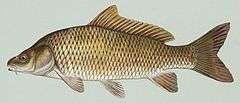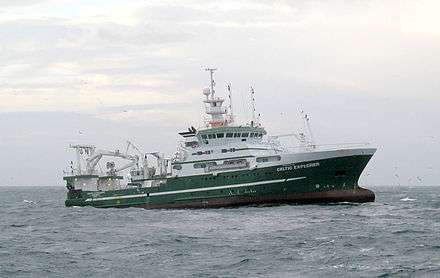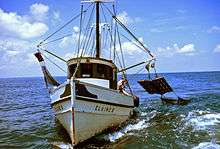Aquaculture
Aquaculture (less commonly spelled aquiculture[2]), also known as aquafarming, is the farming of fish, crustaceans, molluscs, aquatic plants, algae, and other organisms. Aquaculture involves cultivating freshwater and saltwater populations under controlled conditions, and can be contrasted with commercial fishing, which is the harvesting of wild fish.[3] Mariculture refers to aquaculture practiced in marine environments and in underwater habitats.
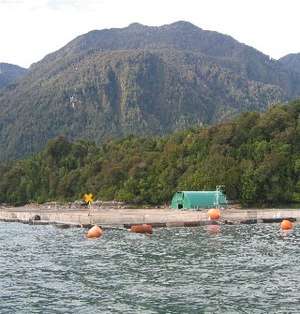
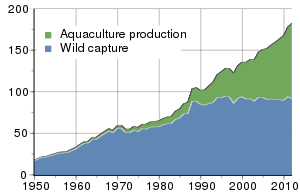
According to the Food and Agriculture Organization (FAO), aquaculture "is understood to mean the farming of aquatic organisms including fish, molluscs, crustaceans and aquatic plants. Farming implies some form of intervention in the rearing process to enhance production, such as regular stocking, feeding, protection from predators, etc. Farming also implies individual or corporate ownership of the stock being cultivated."[4] The reported output from global aquaculture operations in 2014 supplied over one half of the fish and shellfish that is directly consumed by humans;[5][6] however, there are issues about the reliability of the reported figures.[7] Further, in current aquaculture practice, products from several pounds of wild fish are used to produce one pound of a piscivorous fish like salmon.[8]
Particular kinds of aquaculture include fish farming, shrimp farming, oyster farming, mariculture, algaculture (such as seaweed farming), and the cultivation of ornamental fish. Particular methods include aquaponics and integrated multi-trophic aquaculture, both of which integrate fish farming and aquatic plant farming.
History
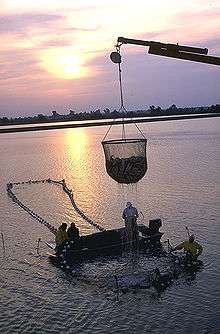
The Gunditjmara, the local Aboriginal Australian people in south-western Victoria, Australia, may have raised short-finned eels as early as about 4,580 BCE (6,600 years BP).[9] Evidence indicates they developed about 100 km2 (39 sq mi) of volcanic floodplains in the vicinity of Lake Condah into a complex of channels and dams, and used woven traps to capture eels, and preserve them to eat all year round.[10][11] The Budj Bim Cultural Landscape, a World Heritage Site, is thought to be one of the oldest aquaculture sites in the world.[12][13]
Oral tradition in China tells of the culture of the common carp, Cyprinus carpio, as long ago as 2000–2100 BCE (around 4,000 years BP), but the earliest significant evidence lies in the literature, in the earliest monograph on fish culture called The Classic of Fish Culture, by Fan Lai, written around 475 BCE (c.2475 BP).[14] Another ancient Chinese guide to aquaculture was by Yang Yu Jing, written around 460 BCE, showing that carp farming was becoming more sophisticated. The Jiahu site in China has circumstantial archeological evidence as possibly the oldest aquaculture locations, dating from 6200BCE (about 8,200 years BP), but this is speculative.[15] When the waters subsided after river floods, some fish, mainly carp, were trapped in lakes. Early aquaculturists fed their brood using nymphs and silkworm faeces, and ate them.[16]
Ancient Egyptians might have farmed fish (especially Gilt-head bream) from Lake Bardawil about 1,500 BCE (3,520 years BP), and they traded them with Canaan.[16]
Gim cultivation is the oldest aquaculture in Korea.[17] Early cultivation methods used bamboo or oak sticks,[17] which were replaced by newer methods that utilized nets in the 19th century.[17][18] Floating rafts have been used for mass production since the 1920s.[17]
Japanese cultivated seaweed by providing bamboo poles and, later, nets and oyster shells to serve as anchoring surfaces for spores.
Romans bred fish in ponds and farmed oysters in coastal lagoons before 100 CE.[19]
In central Europe, early Christian monasteries adopted Roman aquacultural practices.[20] Aquaculture spread in Europe during the Middle Ages since away from the seacoasts and the big rivers, fish had to be salted so they did not rot.[21] Improvements in transportation during the 19th century made fresh fish easily available and inexpensive, even in inland areas, making aquaculture less popular. The 15th-century fishponds of the Trebon Basin in the Czech Republic are maintained as a UNESCO World Heritage Site.[22]
Hawaiians constructed oceanic fish ponds. A remarkable example is the "Menehune" fishpond dating from at least 1,000 years ago, at Alekoko. Legend says that it was constructed by the mythical Menehune dwarf people.[23]
In the first half of the 18th century, German Stephan Ludwig Jacobi experimented with external fertilization of brown trouts and salmon. He wrote an article "Von der künstlichen Erzeugung der Forellen und Lachse" (On the Artificial Production of Trout and Salmon) summarizing his findings, and is regarded as the founder of artificial fish rearing in Europe.[24] By the latter decades of the 18th century, oyster farming had begun in estuaries along the Atlantic Coast of North America.[25]
The word aquaculture appeared in an 1855 newspaper article in reference to the harvesting of ice.[26] It also appeared in descriptions of the terrestrial agricultural practise of sub-irrigation in the late 19th century[27] before becoming associated primarily with the cultivation of aquatic plant and animal species.
In 1859, Stephen Ainsworth of West Bloomfield, New York, began experiments with brook trout. By 1864, Seth Green had established a commercial fish-hatching operation at Caledonia Springs, near Rochester, New York. By 1866, with the involvement of Dr. W. W. Fletcher of Concord, Massachusetts, artificial fish hatcheries were under way in both Canada and the United States.[28] When the Dildo Island fish hatchery opened in Newfoundland in 1889, it was the largest and most advanced in the world. The word aquaculture was used in descriptions of the hatcheries experiments with cod and lobster in 1890.[29]
By the 1920s, the American Fish Culture Company of Carolina, Rhode Island, founded in the 1870s was one of the leading producers of trout. During the 1940s, they had perfected the method of manipulating the day and night cycle of fish so that they could be artificially spawned year around.[30]
Californians harvested wild kelp and attempted to manage supply around 1900, later labeling it a wartime resource.[31]
21st-century practice

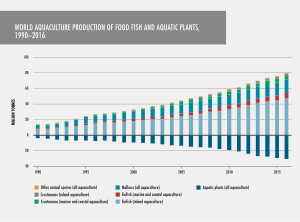
Harvest stagnation in wild fisheries and overexploitation of popular marine species, combined with a growing demand for high-quality protein, encouraged aquaculturists to domesticate other marine species.[32][33] At the outset of modern aquaculture, many were optimistic that a "Blue Revolution" could take place in aquaculture, just as the Green Revolution of the 20th century had revolutionized agriculture.[34] Although land animals had long been domesticated, most seafood species were still caught from the wild. Concerned about the impact of growing demand for seafood on the world's oceans, prominent ocean explorer Jacques Cousteau wrote in 1973: "With earth's burgeoning human populations to feed, we must turn to the sea with new understanding and new technology."[35]
About 430 (97%) of the species cultured as of 2007 were domesticated during the 20th and 21st centuries, of which an estimated 106 came in the decade to 2007. Given the long-term importance of agriculture, to date, only 0.08% of known land plant species and 0.0002% of known land animal species have been domesticated, compared with 0.17% of known marine plant species and 0.13% of known marine animal species. Domestication typically involves about a decade of scientific research.[36] Domesticating aquatic species involves fewer risks to humans than do land animals, which took a large toll in human lives. Most major human diseases originated in domesticated animals,[37] including diseases such as smallpox and diphtheria, that like most infectious diseases, move to humans from animals. No human pathogens of comparable virulence have yet emerged from marine species. [38]
Biological control methods to manage parasites are already being used, such as cleaner fish (e.g. lumpsuckers and wrasse) to control sea lice populations in salmon farming.[39] Models are being used to help with spatial planning and siting of fish farms in order to minimize impact.[40]
The decline in wild fish stocks has increased the demand for farmed fish.[41] However, finding alternative sources of protein and oil for fish feed is necessary so the aquaculture industry can grow sustainably; otherwise, it represents a great risk for the over-exploitation of forage fish.[42]
Another recent issue following the banning in 2008 of organotins by the International Maritime Organization is the need to find environmentally friendly, but still effective, compounds with antifouling effects.
Many new natural compounds are discovered every year, but producing them on a large enough scale for commercial purposes is almost impossible.
It is highly probable that future developments in this field will rely on microorganisms, but greater funding and further research is needed to overcome the lack of knowledge in this field.[43]
Species groups
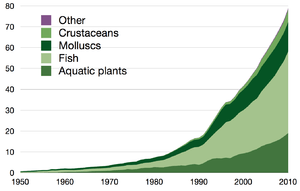

Aquatic plants
Microalgae, also referred to as phytoplankton, microphytes, or planktonic algae, constitute the majority of cultivated algae. Macroalgae commonly known as seaweed also have many commercial and industrial uses, but due to their size and specific requirements, they are not easily cultivated on a large scale and are most often taken in the wild.
In 2016, aquaculture was the source of 96.5 percent by volume of the total 31.2 million tonnes of wild-collected and cultivated aquatic plants combined. Global production of farmed aquatic plants, overwhelmingly dominated by seaweeds, grew in output volume from 13.5 million tonnes in 1995 to just over 30 million tonnes in 2016.[44]
Seaweed farming
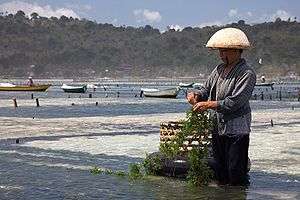
Seaweed farming or kelp farming is the practice of cultivating and harvesting seaweed. In its simplest form, it consists of the management of naturally found batches. In its most advanced form, it consists of fully controlling the life cycle of the algae.
The main food species grown by aquaculture in Japan, China and Korea include Gelidium, Pterocladia,[45] Porphyra,[46] and Laminaria.[47] Seaweed farming has frequently been developed as an alternative to improve economic conditions and to reduce fishing pressure and overexploited fisheries. Seaweeds have been harvested throughout the world as a food source as well as an export commodity for production of agar and carrageenan products.[48]
Global production of farmed aquatic plants, overwhelmingly dominated by seaweeds, grew in output volume from 13.5 million tonnes in 1995 to just over 30 million tonnes in 2016.[49] As of 2014, seaweed was 27% of all marine aquaculture.[50] Seaweed farming is a carbon negative crop, with a high potential for climate change mitigation .[50] The IPCC Special Report on the Ocean and Cryosphere in a Changing Climate recommends "further research attention" as a mitigation tactic.[51]
Fish
The farming of fish is the most common form of aquaculture. It involves raising fish commercially in tanks, fish ponds, or ocean enclosures, usually for food. A facility that releases juvenile fish into the wild for recreational fishing or to supplement a species' natural numbers is generally referred to as a fish hatchery. Worldwide, the most important fish species used in fish farming are, in order, carp, salmon, tilapia, and catfish.[1]
In the Mediterranean, young bluefin tuna are netted at sea and towed slowly towards the shore. They are then interned in offshore pens (sometimes made from floating HDPE pipe)[52] where they are further grown for the market.[53] In 2009, researchers in Australia managed for the first time to coax southern bluefin tuna to breed in landlocked tanks. Southern bluefin tuna are also caught in the wild and fattened in grow-out sea cages in southern Spencer Gulf, South Australia.
A similar process is used in the salmon-farming section of this industry; juveniles are taken from hatcheries and a variety of methods are used to aid them in their maturation. For example, as stated above, some of the most important fish species in the industry, salmon, can be grown using a cage system. This is done by having netted cages, preferably in open water that has a strong flow, and feeding the salmon a special food mixture that aids their growth. This process allows for year-round growth of the fish, thus a higher harvest during the correct seasons.[54][55] An additional method, known sometimes as sea ranching, has also been used within the industry. Sea ranching involves raising fish in a hatchery for a brief time and then releasing them into marine waters for further development, whereupon the fish are recaptured when they have matured.[56]
Crustaceans
Commercial shrimp farming began in the 1970s, and production grew steeply thereafter. Global production reached more than 1.6 million tonnes in 2003, worth about US$9 billion. About 75% of farmed shrimp is produced in Asia, in particular in China and Thailand. The other 25% is produced mainly in Latin America, where Brazil is the largest producer. Thailand is the largest exporter.
Shrimp farming has changed from its traditional, small-scale form in Southeast Asia into a global industry. Technological advances have led to ever higher densities per unit area, and broodstock is shipped worldwide. Virtually all farmed shrimp are penaeids (i.e., shrimp of the family Penaeidae), and just two species of shrimp, the Pacific white shrimp and the giant tiger prawn, account for about 80% of all farmed shrimp. These industrial monocultures are very susceptible to disease, which has decimated shrimp populations across entire regions. Increasing ecological problems, repeated disease outbreaks, and pressure and criticism from both nongovernmental organizations and consumer countries led to changes in the industry in the late 1990s and generally stronger regulations. In 1999, governments, industry representatives, and environmental organizations initiated a program aimed at developing and promoting more sustainable farming practices through the Seafood Watch program.[57]
Freshwater prawn farming shares many characteristics with, including many problems with, marine shrimp farming. Unique problems are introduced by the developmental lifecycle of the main species, the giant river prawn.[58]
The global annual production of freshwater prawns (excluding crayfish and crabs) in 2007 was about 460,000 tonnes, exceeding 1.86 billion dollars.[59] Additionally, China produced about 370,000 tonnes of Chinese river crab.[60]
In addition astaciculture is the freshwater farming of crayfish (mostly in the US, Australia, and Europe).[61]
Molluscs
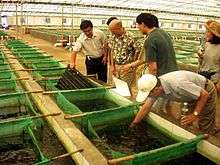
Aquacultured shellfish include various oyster, mussel, and clam species. These bivalves are filter and/or deposit feeders, which rely on ambient primary production rather than inputs of fish or other feed. As such, shellfish aquaculture is generally perceived as benign or even beneficial.[62]
Depending on the species and local conditions, bivalve molluscs are either grown on the beach, on longlines, or suspended from rafts and harvested by hand or by dredging. In May 2017 a Belgian consortium installed the first of two trial mussel farms on a wind farm in the North Sea.[63]
Abalone farming began in the late 1950s and early 1960s in Japan and China.[64] Since the mid-1990s, this industry has become increasingly successful.[65] Overfishing and poaching have reduced wild populations to the extent that farmed abalone now supplies most abalone meat. Sustainably farmed molluscs can be certified by Seafood Watch and other organizations, including the World Wildlife Fund (WWF). WWF initiated the "Aquaculture Dialogues" in 2004 to develop measurable and performance-based standards for responsibly farmed seafood. In 2009, WWF co-founded the Aquaculture Stewardship Council with the Dutch Sustainable Trade Initiative to manage the global standards and certification programs.[66]
After trials in 2012,[67] a commercial "sea ranch" was set up in Flinders Bay, Western Australia, to raise abalone. The ranch is based on an artificial reef made up of 5000 (As of April 2016) separate concrete units called abitats (abalone habitats). The 900 kg abitats can host 400 abalone each. The reef is seeded with young abalone from an onshore hatchery. The abalone feed on seaweed that has grown naturally on the habitats, with the ecosystem enrichment of the bay also resulting in growing numbers of dhufish, pink snapper, wrasse, and Samson fish, among other species.
Brad Adams, from the company, has emphasised the similarity to wild abalone and the difference from shore-based aquaculture. "We're not aquaculture, we're ranching, because once they're in the water they look after themselves."[68][69]
Other groups
Other groups include aquatic reptiles, amphibians, and miscellaneous invertebrates, such as echinoderms and jellyfish. They are separately graphed at the top right of this section, since they do not contribute enough volume to show clearly on the main graph.
Commercially harvested echinoderms include sea cucumbers and sea urchins. In China, sea cucumbers are farmed in artificial ponds as large as 1,000 acres (400 ha).[70]
Around the world
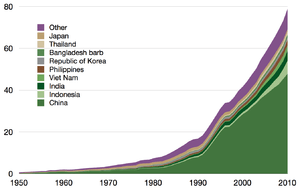
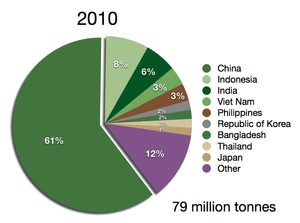
Global fish production peaked at about 171 million tonnes in 2016, with aquaculture representing 47 percent of the total and 53 percent if non-food uses (including reduction to fishmeal and fish oil) are excluded. With capture fishery production relatively static since the late 1980s, aquaculture has been responsible for the continuing growth in the supply of fish for human consumption.[44] Global aquaculture production (including aquatic plants) in 2016 was 110.2 million tonnes, with the first-sale value estimated at US$243.5 billion. The contribution of aquaculture to the global production of capture fisheries and aquaculture combined has risen continuously, reaching 46.8 percent in 2016, up from 25.7 percent in 2000. With 5.8 percent annual growth rate during the period 2001–2016, aquaculture continues to grow faster than other major food production sectors, but it no longer has the high annual growth rates experienced in the 1980s and 1990s.[44]
In 2012, the total world production of fisheries was 158 million tonnes, of which aquaculture contributed 66.6 million tonnes, about 42%.[71] The growth rate of worldwide aquaculture has been sustained and rapid, averaging about 8% per year for over 30 years, while the take from wild fisheries has been essentially flat for the last decade. The aquaculture market reached $86 billion[72] in 2009.[73]
Aquaculture is an especially important economic activity in China. Between 1980 and 1997, the Chinese Bureau of Fisheries reports, aquaculture harvests grew at an annual rate of 16.7%, jumping from 1.9 million tonnes to nearly 23 million tonnes. In 2005, China accounted for 70% of world production.[74][75] Aquaculture is also currently one of the fastest-growing areas of food production in the U.S.[76]
About 90% of all U.S. shrimp consumption is farmed and imported.[77] In recent years, salmon aquaculture has become a major export in southern Chile, especially in Puerto Montt, Chile's fastest-growing city.
A United Nations report titled The State of the World Fisheries and Aquaculture released in May 2014 maintained fisheries and aquaculture support the livelihoods of some 60 million people in Asia and Africa.[78] FAO estimates that in 2016, overall, women accounted for nearly 14 percent of all people directly engaged in the fisheries and aquaculture primary sector.[44]
| Category | 2011 | 2012 | 2013 | 2014 | 2015 | 2016 |
| Production | ||||||
| Capture | ||||||
| Inland | 10.7 | 11.2 | 11.2 | 11.3 | 11.4 | 11.6 |
| Marine | 81.5 | 78.4 | 79.4 | 79.9 | 81.2 | 79.3 |
| Total capture | 92.2 | 89.5 | 90.6 | 91.2 | 92.7 | 90.9 |
| Aquaculture | ||||||
| Inland | 38.6 | 42 | 44.8 | 46.9 | 48.6 | 51.4 |
| Marine | 23.2 | 24.4 | 25.4 | 26.8 | 27.5 | 28.7 |
| Total aquaculture | 61.8 | 66.4 | 70.2 | 73.7 | 76.1 | 80 |
| Total world fisheries and aquaculture | 154 | 156 | 160.7 | 164.9 | 168.7 | 170.9 |
| Utilization | ||||||
| Human consumption | 130 | 136.4 | 140.1 | 144.8 | 148.4 | 151.2 |
| Non-food uses | 24 | 19.6 | 20.6 | 20 | 20.3 | 19.7 |
| Population (billions) | 7 | 7.1 | 7.2 | 7.3 | 7.3 | 7.4 |
| Per capita apparent consumption (kg) | 18.5 | 19.2 | 19.5 | 19.9 | 20.2 | 20.3[44] |
National laws, regulations, and management
Laws governing aquaculture practices vary greatly by country[79] and are often not closely regulated or easily traceable. In the United States, land-based and nearshore aquaculture is regulated at the federal and state levels;[80] however, no national laws govern offshore aquaculture in U.S. exclusive economic zone waters. In June 2011, the Department of Commerce and National Oceanic and Atmospheric Administration released national aquaculture policies[81] to address this issue and "to meet the growing demand for healthy seafood, to create jobs in coastal communities, and restore vital ecosystems." In 2011, Congresswoman Lois Capps introduced the National Sustainable Offshore Aquaculture Act of 2011[82] "to establish a regulatory system and research program for sustainable offshore aquaculture in the United States exclusive economic zone"; however, the bill was not enacted into law.
Over-reporting
China overwhelmingly dominates the world in reported aquaculture output,[83] reporting a total output which is double that of the rest of the world put together. However, there are some historical issues with the accuracy of China's returns.
In 2001, the fisheries scientists Reg Watson and Daniel Pauly expressed concerns in a letter to Nature, that China was over reporting its catch from wild fisheries in the 1990s.[7][84] They said that made it appear that the global catch since 1988 was increasing annually by 300,000 tonnes, whereas it was really shrinking annually by 350,000 tonnes. Watson and Pauly suggested this may be have been related to Chinese policies where state entities that monitored the economy were also tasked with increasing output. Also, until more recently, the promotion of Chinese officials was based on production increases from their own areas.[85][86]
China disputed this claim. The official Xinhua News Agency quoted Yang Jian, director general of the Agriculture Ministry's Bureau of Fisheries, as saying that China's figures were "basically correct".[87] However, the FAO accepted there were issues with the reliability of China's statistical returns, and for a period treated data from China, including the aquaculture data, apart from the rest of the world.[88][89]
Aquacultural methods
Mariculture
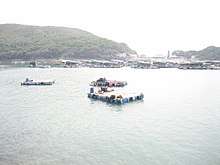
Mariculture refers to the cultivation of marine organisms in seawater, usually in sheltered coastal or offshore waters. The farming of marine fish is an example of mariculture, and so also is the farming of marine crustaceans (such as shrimp), mollusks (such as oysters), and seaweed. Channel catfish (Ictalurus punctatus), hard clams (Mercenaria mercenaria) and Atlantic salmon (Salmo salar) are prominent in the U.S. mariculture.[91]
Mariculture may consist of raising the organisms on or in artificial enclosures such as in floating netted enclosures for salmon and on racks for oysters. In the case of enclosed salmon, they are fed by the operators; oysters on racks filter feed on naturally available food. Abalone have been farmed on an artificial reef consuming seaweed which grows naturally on the reef units.[69]
Integrated
Integrated multi-trophic aquaculture (IMTA) is a practice in which the byproducts (wastes) from one species are recycled to become inputs (fertilizers, food) for another. Fed aquaculture (for example, fish, shrimp) is combined with inorganic extractive and organic extractive (for example, shellfish) aquaculture to create balanced systems for environmental sustainability (biomitigation), economic stability (product diversification and risk reduction) and social acceptability (better management practices).[92]
"Multi-trophic" refers to the incorporation of species from different trophic or nutritional levels in the same system.[93] This is one potential distinction from the age-old practice of aquatic polyculture, which could simply be the co-culture of different fish species from the same trophic level. In this case, these organisms may all share the same biological and chemical processes, with few synergistic benefits, which could potentially lead to significant shifts in the ecosystem. Some traditional polyculture systems may, in fact, incorporate a greater diversity of species, occupying several niches, as extensive cultures (low intensity, low management) within the same 2006"/> A working IMTA system can result in greater total production based on mutual benefits to the co-cultured species and improved ecosystem health, even if the production of individual species is lower than in a monoculture over a short-term period.[94]
Sometimes the term "integrated aquaculture" is used to describe the integration of monocultures through water transfer.[94] For all intents and purposes, however, the terms "IMTA" and "integrated aquaculture" differ only in their degree of descriptiveness. Aquaponics, fractionated aquaculture, integrated agriculture-aquaculture systems, integrated peri-urban-aquaculture systems, and integrated fisheries-aquaculture systems are other variations of the IMTA concept.
Netting materials
Various materials, including nylon, polyester, polypropylene, polyethylene, plastic-coated welded wire, rubber, patented rope products (Spectra, Thorn-D, Dyneema), galvanized steel and copper are used for netting in aquaculture fish enclosures around the world.[95][96][97][98][99] All of these materials are selected for a variety of reasons, including design feasibility, material strength, cost, and corrosion resistance.
Recently, copper alloys have become important netting materials in aquaculture because they are antimicrobial (i.e., they destroy bacteria, viruses, fungi, algae, and other microbes) and they therefore prevent biofouling (i.e., the undesirable accumulation, adhesion, and growth of microorganisms, plants, algae, tubeworms, barnacles, mollusks, and other organisms). By inhibiting microbial growth, copper alloy aquaculture cages avoid costly net changes that are necessary with other materials. The resistance of organism growth on copper alloy nets also provides a cleaner and healthier environment for farmed fish to grow and thrive.
Issues
If performed without consideration for potential local environmental impacts, aquaculture in inland waters can result in more environmental damage than wild fisheries, though with less waste produced per kg on a global scale.[100] Local concerns with aquaculture in inland waters may include waste handling, side-effects of antibiotics, competition between farmed and wild animals, and the potential introduction of invasive plant and animal species, or foreign pathogens, particularly if unprocessed fish are used to feed more marketable carnivorous fish. If non-local live feeds are used, aquaculture may introduce exotic plants or animals with disastrous effects. Improvements in methods resulting from advances in research and the availability of commercial feeds has reduced some of these concerns since their greater prevalence in the 1990s and 2000s .[101][102]
Fish waste is organic and composed of nutrients necessary in all components of aquatic food webs. In-ocean aquaculture often produces much higher than normal fish waste concentrations. The waste collects on the ocean bottom, damaging or eliminating bottom-dwelling life.[103] Waste can also decrease dissolved oxygen levels in the water column, putting further pressure on wild animals.[104] An alternative model to food being added to the ecosystem, is the installation of artificial reef structures to increase the habitat niches available, without the need to add any more than ambient feed and nutrient. This has been used in the "ranching" of abalone in Western Australia.[69]
Fish oils
Tilapia from aquaculture has been shown to contain more fat and a much higher ratio of omega-6 to omega-3 oils.
Impacts on wild fish
Some carnivorous and omnivorous farmed fish species are fed wild forage fish. Although carnivorous farmed fish represented only 13 percent of aquaculture production by weight in 2000, they represented 34 percent of aquaculture production by value.[105]
Farming of carnivorous species like salmon and shrimp leads to a high demand for forage fish to match the nutrition they get in the wild. Fish do not actually produce omega-3 fatty acids, but instead accumulate them from either consuming microalgae that produce these fatty acids, as is the case with forage fish like herring and sardines, or, as is the case with fatty predatory fish, like salmon, by eating prey fish that have accumulated omega-3 fatty acids from microalgae. To satisfy this requirement, more than 50 percent of the world fish oil production is fed to farmed salmon.[106]
Farmed salmon consume more wild fish than they generate as a final product, although the efficiency of production is improving. To produce one pound of farmed salmon, products from several pounds of wild fish are fed to them - this can be described as the "fish-in-fish-out" (FIFO) ratio. In 1995, salmon had a FIFO ratio of 7.5 (meaning 7.5 pounds of wild fish feed were required to produce 1 pound of salmon); by 2006 the ratio had fallen to 4.9.[107] Additionally, a growing share of fish oil and fishmeal come from residues (byproducts of fish processing), rather than dedicated whole fish. In 2012, 34 percent of fish oil and 28 percent of fishmeal came from residues.[108] However, fishmeal and oil from residues instead of whole fish have a different composition with more ash and less protein, which may limit its potential use for aquaculture.
As the salmon farming industry expands, it requires more wild forage fish for feed, at a time when seventy five percent of the worlds monitored fisheries are already near to or have exceeded their maximum sustainable yield.[8] The industrial scale extraction of wild forage fish for salmon farming then impacts the survivability of the wild predator fish who rely on them for food. An important step in reducing the impact of aquaculture on wild fish is shifting carnivorous species to plant-based feeds. Salmon feeds, for example, have gone from containing only fishmeal and oil to containing 40 percent plant protein.[109] The USDA has also experimented with using grain-based feeds for farmed trout.[110] When properly formulated (and often mixed with fishmeal or oil), plant-based feeds can provide proper nutrition and similar growth rates in carnivorous farmed fish.[111]
Another impact aquaculture production can have on wild fish is the risk of fish escaping from coastal pens, where they can interbreed with their wild counterparts, diluting wild genetic stocks.[112] Escaped fish can become invasive, out-competing native species.[113][114][115]
Coastal ecosystems
Aquaculture is becoming a significant threat to coastal ecosystems. About 20 percent of mangrove forests have been destroyed since 1980, partly due to shrimp farming.[116] An extended cost–benefit analysis of the total economic value of shrimp aquaculture built on mangrove ecosystems found that the external costs were much higher than the external benefits.[117] Over four decades, 269,000 hectares (660,000 acres) of Indonesian mangroves have been converted to shrimp farms. Most of these farms are abandoned within a decade because of the toxin build-up and nutrient loss.[118][119]
Pollution from sea cage aquaculture
Salmon farms are typically sited in pristine coastal ecosystems which they then pollute. A farm with 200,000 salmon discharges more fecal waste than a city of 60,000 people. This waste is discharged directly into the surrounding aquatic environment, untreated, often containing antibiotics and pesticides."[8] There is also an accumulation of heavy metals on the benthos (seafloor) near the salmon farms, particularly copper and zinc.[120]
In 2016, mass fish kill events impacted salmon farmers along Chile's coast and the wider ecology.[121] Increases in aquaculture production and its associated effluent were considered to be possible contributing factors to fish and molluscan mortality.[122]
Sea cage aquaculture is responsible for nutrient enrichment of the waters in which they are established. This results from fish wastes and uneaten feed inputs. Elements of most concern are nitrogen and phosphorus which can promote algal growth, including harmful algal blooms which can be toxic to fish. Flushing times, current speeds, distance from the shore and water depth are important considerations when locating sea cages in order to minimize the impacts of nutrient enrichment on coastal ecosystems.
The extent of the effects of pollution from sea-cage aquaculture varies depending on where the cages are located, which species are kept, how densely cages are stocked and what the fish are fed. Important species-specific variables include the species' food conversion ratio (FCR) and nitrogen retention. Studies prior to 2001 determined that the amount of nitrogen introduced as feed which is lost to the water column and seafloor as waste varies from 52 to 95%.
Genetic modification
A type of salmon called the AquAdvantage salmon has been genetically modified for faster growth, although it has not been approved for commercial use, due to controversy.[123] The altered salmon incorporates a growth hormone from a Chinook salmon that allows it to reach full size in 16–28 months, instead of the normal 36 months for Atlantic salmon, and while consuming 25 percent less feed.[124] The U.S. Food and Drug Administration reviewed the AquAdvantage salmon in a draft environmental assessment and determined that it "would not have a significant impact (FONSI) on the U.S. environment."[125]
Ecological benefits
While some forms of aquaculture can be devastating to ecosystems, such as shrimp farming in mangroves, other forms can be very beneficial. Shellfish aquaculture adds substantial filter feeding capacity to an environment which can significantly improve water quality. A single oyster can filter 15 gallons of water a day, removing microscopic algal cells. By removing these cells, shellfish are removing nitrogen and other nutrients from the system and either retaining it or releasing it as waste which sinks to the bottom. By harvesting these shellfish the nitrogen they retained is completely removed from the system.[126] Raising and harvesting kelp and other macroalgae directly remove nutrients such as nitrogen and phosphorus. Repackaging these nutrients can relieve eutrophic, or nutrient-rich, conditions known for their low dissolved oxygen which can decimate species diversity and abundance of marine life. Removing algal cells from the water also increase light penetration, allowing plants such as eelgrass to reestablish themselves and further increase oxygen levels.
Aquaculture in an area can provide for crucial ecological functions for the inhabitants. Shellfish beds or cages can provide habitat structure. This structure can be used as shelter by invertebrates, small fish or crustaceans to potentially increase their abundance and maintain biodiversity. Increased shelter raises stocks of prey fish and small crustaceans by increasing recruitment opportunities in turn providing more prey for higher trophic levels. One study estimated that 10 square meters of oyster reef could enhance an ecosystem's biomass by 2.57 kg[127] The shellfish acting as herbivores will also be preyed on. This moves energy directly from primary producers to higher trophic levels potentially skipping out on multiple energetically-costly trophic jumps which would increase biomass in the ecosystem.
Seaweed farming is a carbon negative crop, with a high potential for climate change mitigation .[128] The IPCC Special Report on the Ocean and Cryosphere in a Changing Climate recommends "further research attention" as a mitigation tactic.[129]
Animal welfare
As with the farming of terrestrial animals, social attitudes influence the need for humane practices and regulations in farmed marine animals. Under the guidelines advised by the Farm Animal Welfare Council good animal welfare means both fitness and a sense of well being in the animal's physical and mental state. This can be defined by the Five Freedoms:
- Freedom from hunger & thirst
- Freedom from discomfort
- Freedom from pain, disease, or injury
- Freedom to express normal behaviour
- Freedom from fear and distress
However, the controversial issue in aquaculture is whether fish and farmed marine invertebrates are actually sentient, or have the perception and awareness to experience suffering. Although no evidence of this has been found in marine invertebrates,[130] recent studies conclude that fish do have the necessary receptors (nociceptors) to sense noxious stimuli and so are likely to experience states of pain, fear and stress.[130][131] Consequently, welfare in aquaculture is directed at vertebrates; finfish in particular.[132]
Common welfare concerns
Welfare in aquaculture can be impacted by a number of issues such as stocking densities, behavioural interactions, disease and parasitism. A major problem in determining the cause of impaired welfare is that these issues are often all interrelated and influence each other at different times.[133]
Optimal stocking density is often defined by the carrying capacity of the stocked environment and the amount of individual space needed by the fish, which is very species specific. Although behavioural interactions such as shoaling may mean that high stocking densities are beneficial to some species,[130][134] in many cultured species high stocking densities may be of concern. Crowding can constrain normal swimming behaviour, as well as increase aggressive and competitive behaviours such as cannibalism,[135] feed competition,[136] territoriality and dominance/subordination hierarchies.[137] This potentially increases the risk of tissue damage due to abrasion from fish-to-fish contact or fish-to-cage contact.[130] Fish can suffer reductions in food intake and food conversion efficiency.[137] In addition, high stocking densities can result in water flow being insufficient, creating inadequate oxygen supply and waste product removal.[134] Dissolved oxygen is essential for fish respiration and concentrations below critical levels can induce stress and even lead to asphyxiation.[137] Ammonia, a nitrogen excretion product, is highly toxic to fish at accumulated levels, particularly when oxygen concentrations are low.[138]
Many of these interactions and effects cause stress in the fish, which can be a major factor in facilitating fish disease.[132] For many parasites, infestation depends on the host's degree of mobility, the density of the host population and vulnerability of the host's defence system.[139] Sea lice are the primary parasitic problem for finfish in aquaculture, high numbers causing widespread skin erosion and haemorrhaging, gill congestion, and increased mucus production.[140] There are also a number of prominent viral and bacterial pathogens that can have severe effects on internal organs and nervous systems.[141]
Improving welfare
The key to improving welfare of marine cultured organisms is to reduce stress to a minimum, as prolonged or repeated stress can cause a range of adverse effects. Attempts to minimise stress can occur throughout the culture process. During grow out it is important to keep stocking densities at appropriate levels specific to each species, as well as separating size classes and grading to reduce aggressive behavioural interactions. Keeping nets and cages clean can assist positive water flow to reduce the risk of water degradation.
Not surprisingly disease and parasitism can have a major effect on fish welfare and it is important for farmers not only to manage infected stock but also to apply disease prevention measures. However, prevention methods, such as vaccination, can also induce stress because of the extra handling and injection.[134] Other methods include adding antibiotics to feed, adding chemicals into water for treatment baths and biological control, such as using cleaner wrasse to remove lice from farmed salmon.[134]
Many steps are involved in transport, including capture, food deprivation to reduce faecal contamination of transport water, transfer to transport vehicle via nets or pumps, plus transport and transfer to the delivery location. During transport water needs to be maintained to a high quality, with regulated temperature, sufficient oxygen and minimal waste products.[132][134] In some cases anaesthetics may be used in small doses to calm fish before transport.[134]
Aquaculture is sometimes part of an environmental rehabilitation program or as an aid in conserving endangered species.[142]
Prospects
Global wild fisheries are in decline, with valuable habitat such as estuaries in critical condition.[143] The aquaculture or farming of piscivorous fish, like salmon, does not help the problem because they need to eat products from other fish, such as fish meal and fish oil. Studies have shown that salmon farming has major negative impacts on wild salmon, as well as the forage fish that need to be caught to feed them.[144][145] Fish that are higher on the food chain are less efficient sources of food energy.
Apart from fish and shrimp, some aquaculture undertakings, such as seaweed and filter-feeding bivalve mollusks like oysters, clams, mussels and scallops, are relatively benign and even environmentally restorative.[33] Filter-feeders filter pollutants as well as nutrients from the water, improving water quality.[146] Seaweeds extract nutrients such as inorganic nitrogen and phosphorus directly from the water,[92] and filter-feeding mollusks can extract nutrients as they feed on particulates, such as phytoplankton and detritus.[147]
Some profitable aquaculture cooperatives promote sustainable practices.[148] New methods lessen the risk of biological and chemical pollution through minimizing fish stress, fallowing netpens, and applying Integrated Pest Management. Vaccines are being used more and more to reduce antibiotic use for disease control.[149]
Onshore recirculating aquaculture systems, facilities using polyculture techniques, and properly sited facilities (for example, offshore areas with strong currents) are examples of ways to manage negative environmental effects.
Recirculating aquaculture systems (RAS) recycle water by circulating it through filters to remove fish waste and food and then recirculating it back into the tanks. This saves water and the waste gathered can be used in compost or, in some cases, could even be treated and used on land. While RAS was developed with freshwater fish in mind, scientist associated with the Agricultural Research Service have found a way to rear saltwater fish using RAS in low-salinity waters.[150] Although saltwater fish are raised in off-shore cages or caught with nets in water that typically has a salinity of 35 parts per thousand (ppt), scientists were able to produce healthy pompano, a saltwater fish, in tanks with a salinity of only 5 ppt. Commercializing low-salinity RAS are predicted to have positive environmental and economical effects. Unwanted nutrients from the fish food would not be added to the ocean and the risk of transmitting diseases between wild and farm-raised fish would greatly be reduced. The price of expensive saltwater fish, such as the pompano and combia used in the experiments, would be reduced. However, before any of this can be done researchers must study every aspect of the fish's lifecycle, including the amount of ammonia and nitrate the fish will tolerate in the water, what to feed the fish during each stage of its lifecycle, the stocking rate that will produce the healthiest fish, etc.[150]
Some 16 countries now use geothermal energy for aquaculture, including China, Israel, and the United States.[151] In California, for example, 15 fish farms produce tilapia, bass, and catfish with warm water from underground. This warmer water enables fish to grow all year round and mature more quickly. Collectively these California farms produce 4.5 million kilograms of fish each year.[151]
See also
- Agroecology
- Alligator farm
- Aquaponics
- Blue revolution
- Copper alloys in aquaculture
- Maggots used as food for fish
- Fish hatchery
- Fisheries science
- Industrial aquaculture
- List of commercially important fish species
- Recirculating aquaculture system
- Resource decoupling
Aquaculture by Country:
- Aquaculture in Australia
- Aquaculture in Canada
- Aquaculture in Chile
- Aquaculture in China
- Aquaculture in East Timor
- Aquaculture in the Federated States of Micronesia
- Aquaculture in Fiji
- Aquaculture in Indonesia
- Aquaculture in Kiribati
- Aquaculture in Madagascar
- Aquaculture in the Marshall Islands
- Aquaculture in Nauru
- Aquaculture in New Zealand
- Aquaculture in Palau
- Aquaculture in Papua New Guinea
- Aquaculture in Samoa
- Aquaculture in the Solomon Islands
- Aquaculture in South Africa
- Aquaculture in South Korea
- Aquaculture in Tonga
- Aquaculture in Tuvalu
- Aquaculture in Vanuatu
Sources
![]()
Notes
- Based on data sourced from the FishStat database Archived November 7, 2012, at the Wayback Machine
- Garner, Bryan A. (2016), Garner's Modern English Usage (4th ed.), ISBN 978-0190491482
- "Answers - The Most Trusted Place for Answering Life's Questions". Answers.com.
- Global Aquaculture Production Fishery Statistical Collections, FAO, Rome. Retrieved 2 October 2011.
- Half Of Fish Consumed Globally Is Now Raised On Farms, Study Finds Science Daily, September 8, 2009.
- 2016 The State of the Worlds Fisheries and Aquaculture (PDF). Food and Agriculture Organization. Rome, Italy: United Nations. 2016. p. 77. ISBN 978-92-5-109185-2. Retrieved 2016-10-30.
- Watson, Reg; Pauly, Daniel (2001). "Systematic distortions in world Fisheries catch trends". Nature. 414 (6863): 534–6. Bibcode:2001Natur.414..534W. doi:10.1038/35107050. PMID 11734851. Archived from the original on 2010-05-31.
- Seafood Choices Alliance (2005) It's all about salmon Archived 2015-09-24 at the Wayback Machine
- "National Heritage Places - Budj Bim National Heritage Landscape". Australian Government. Dept of Agriculture, Water and the Environment. Retrieved 30 January 2020. See also attached documents: National Heritage List Location and Boundary Map, and Government Gazette, 20 July 2004.
- Aborigines may have farmed eels, built huts ABC Science News, 13 March 2003.
- Lake Condah Sustainability Project Archived 2013-01-03 at Archive.today. Retrieved 18 February 2010.
- Neal, Matt. "Ancient Indigenous aquaculture site Budj Bim added to UNESCO World Heritage list". Retrieved 14 July 2019.
- "World heritage Places - Budj Bim Cultural Landscape". Australian Government. Dept of the Environment and Energy. 6 July 2019. Retrieved 11 March 2020.
- "History of Aquaculture". Food and Agriculture Organization, United Nations. Retrieved August 23, 2009.
- Smith, Kiona N. (17 September 2019). "Aquaculture may be the future of seafood, but its past is ancient". Ars Technica. Archived from the original on 17 September 2019. Retrieved 17 September 2019.
- Sisma-Ventura, Guy; Tütken, Thomas; Zohar, Irit; Pack, Andreas; Sivan, Dorit; Lernau, Omri; Gilboa, Ayelet; Bar-Oz, Guy (2018). "Tooth oxygen isotopes reveal Late Bronze Age origin of Mediterranean fish aquaculture and trade". Scientific Reports. 8 (1): 14086. Bibcode:2018NatSR...814086G. doi:10.1038/s41598-018-32468-1. PMC 6148281. PMID 30237483.
- 강, 제원. "gim" 김. Encyclopedia of Korean Culture (in Korean). Academy of Korean Studies.
- "gim" 김. Encyclopædia Britannica (in Korean). Retrieved 5 June 2017.
- McCann, Anna Marguerite (1979). "The Harbor and Fishery Remains at Cosa, Italy, by Anna Marguerite McCann". Journal of Field Archaeology. 6 (4): 391–411. doi:10.1179/009346979791489014. JSTOR 529424.
- Jhingran, V.G., Introduction to aquaculture. 1987, United Nations Development Programme, Food and Agriculture Organization of the United Nations, Nigerian Institute for Oceanography and Marine Research.
- Kurlansky, Mark (2002). Salt: A World History.
- "Fishpond Network in the Trebon Basin". UNESCO. Archived from the original on 3 October 2015. Retrieved 1 Oct 2015.
- Costa-Pierce, B.A. (1987). "Aquaculture in ancient Hawaii" (PDF). BioScience. 37 (5): 320–331. doi:10.2307/1310688. JSTOR 1310688.
- "Ein Lipper macht sich Gedanken …". Lippisches Landesmuseum Detmold (in German). Retrieved 2019-09-18.
- "A Brief History of Oystering in Narragansett Bay". URI Alumni Magazine, University of Rhode Island. 22 May 2015. Retrieved 1 October 2015.
- "The cultivation of ice (1855) - on Newspapers.com". The Baltimore Sun. Retrieved 2015-12-10.
- "Agricultural. New agricultural practises by A. N. Cole. Subirrigation, methods and results (1888) - on Newspapers.com". Oakland Tribune. Retrieved 2015-12-10.
- Milner, James W. (1874). "The Progress of Fish-culture in the United States". United States Commission of Fish and Fisheries Report of the Commissioner for 1872 and 1873. 535 – 544 <http://penbay.org/cof/cof_1872_1873.html>
- "Food from the sea. Remarkable results of the experiments in cod and lobster,(aquaculture, 1890) - on Newspapers.com". Pittsburgh Dispatch. Retrieved 2015-12-10.
- Rice, M.A. 2010. A brief history of the American Fish Culture Company 1877-1997. Rhode Island History 68(1):20-35. web version
- Neushul, Peter (1989). "Seaweed for War: California's World War I Kelp Industry". Technology and Culture. 30 (3): 561–583. doi:10.2307/3105951. JSTOR 3105951.
- "'FAO: 'Fish farming is the way forward.'(Big Picture)(Food and Agriculture Administration's 'State of Fisheries and Aquaculture' report)." The Ecologist 39.4 (2009): 8-9. Gale Expanded Academic ASAP. Web. 1 October 2009. <http://find.galegroup.com/gtx/start.do?prodId=EAIM.>.
- "The Case for Fish and Oyster Farming Archived 2009-05-12 at the Wayback Machine," Carl Marziali, University of Southern California Trojan Family Magazine, May 17, 2009.
- "The Economist: 'The promise of a blue revolution', Aug. 7, 2003. <http://www.economist.com/node/1974103>
- "Jacques Cousteau, The Ocean World of Jacques Cousteau: The Act of life, World Pub: 1973."
- Duarte, C. M; Marba, N; Holmer, M (2007). "Rapid Domestication of Marine Species". Science. 316 (5823): 382–383. doi:10.1126/science.1138042. hdl:10261/89727. PMID 17446380.
- Guns, Germs, and Steel. New York, New York: W.W. Norton & Company, Inc. 2005. ISBN 978-0-393-06131-4.
- "Aquatic animal disease and human health". Department of Primary Industries. 2016-04-26. Retrieved October 15, 2019.
- Imsland, Albert K.; Reynolds, Patrick; Eliassen, Gerhard; Hangstad, Thor Arne; Foss, Atle; Vikingstad, Erik; Elvegård, Tor Anders (2014-03-20). "The use of lumpfish (Cyclopterus lumpus L.) to control sea lice (Lepeophtheirus salmonis Krøyer) infestations in intensively farmed Atlantic salmon (Salmo salar L.)". Aquaculture. 424–425: 18–23. doi:10.1016/j.aquaculture.2013.12.033.
- "DEPOMOD and AutoDEPOMOD — Ecasa Toolbox". www.ecasatoolbox.org.uk. Archived from the original on 2015-09-25. Retrieved 2015-09-24.
- Naylor, Rosamond L.; Goldburg, Rebecca J.; Primavera, Jurgenne H.; Kautsky, Nils; Beveridge, Malcolm C. M.; Clay, Jason; Folke, Carl; Lubchenco, Jane; Mooney, Harold (2000-06-29). "Effect of aquaculture on world fish supplies". Nature. 405 (6790): 1017–1024. Bibcode:2000Natur.405.1017N. doi:10.1038/35016500. hdl:10862/1737. ISSN 0028-0836. PMID 10890435.
- "Turning the tide" (PDF).
- Qian, Pei-Yuan; Xu, Ying; Fusetani, Nobushino (2009). "Qian, P. Y., Xu, Y. & Fusetani, N. Natural products as antifouling compounds: recent progress and future perspectives". Biofouling. 26 (2): 223–234. doi:10.1080/08927010903470815. PMID 19960389. Retrieved 2015-09-24.
- In brief, The State of World Fisheries and Aquaculture, 2018 (PDF). FAO. 2018.
- Borgese 1980, p. 111.
- Borgese 1980, p. 112.
- Borgese 1980, p. 116.
- Ask 1999, p. 52.
- In brief, The State of World Fisheries and Aquaculture, 2018 (PDF). FAO. 2018.
- Duarte, Carlos M.; Wu, Jiaping; Xiao, Xi; Bruhn, Annette; Krause-Jensen, Dorte (2017). "Can Seaweed Farming Play a Role in Climate Change Mitigation and Adaptation?". Frontiers in Marine Science. 4. doi:10.3389/fmars.2017.00100. ISSN 2296-7745.
- Bindoff, N. L.; Cheung, W. W. L.; Kairo, J. G.; Arístegui, J.; et al. (2019). "Chapter 5: Changing Ocean, Marine Ecosystems, and Dependent Communities" (PDF). IPCC SROCC 2019. pp. 447–587.
- "HDPE Pipe used for Aquaculture pens". Archived from the original on 2019-01-09.
- Volpe, J. (2005). "Dollars without sense: The bait for big-money tuna ranching around the world". BioScience. 55 (4): 301–302. doi:10.1641/0006-3568(2005)055[0301:DWSTBF]2.0.CO;2. ISSN 0006-3568.
- Asche, Frank (2008). "Farming the Sea". Marine Resource Economics. 23 (4): 527–547. doi:10.1086/mre.23.4.42629678. JSTOR 42629678.
- Goldburg, Rebecca; Naylor, Rosamond (February 2005). "Future Seascapes, Fishing, and Fish Farming". Frontiers in Ecology and the Environment. 3 (1): 21–28. doi:10.2307/3868441. JSTOR 3868441.
- Brown, E. Evan (1983). World Fish Farming: Cultivation and Economics (Second ed.). Westport, Connecticut: AVI Publishing. p. 2. ISBN 978-0-87055-427-8.
- "About Seafood Watch". Monterey Bay Aquarium. Archived from the original on 2013-05-11. Retrieved 2013-05-30.
- New, M. B.: Farming Freshwater Prawns; FAO Fisheries Technical Paper 428, 2002. ISSN 0429-9345.
- "Freshwater Prawn Book". Wiley Blackwell. 2010. Retrieved November 25, 2018.
- Data extracted from the FAO Fisheries Global Aquaculture Production Database for freshwater crustaceans. The most recent data are from 2003 and sometimes contain estimates. Retrieved June 28, 2005.
- Holdich, David M. (1993). "A review of astaciculture: freshwater crayfish farming". Aquatic Living Resources. 6 (4): 307–317. doi:10.1051/alr:1993032.
- Burkholder, Joann M.; Shumway, Sandra E. (2011). "Bivalve Shellfish Aquaculture and Eutrophication". Shellfish Aquaculture and the Environment. pp. 155–215. doi:10.1002/9780470960967.ch7. ISBN 9780470960967.
- "Belgians Start Growing Mussels on Offshore Wind Farms". offshoreWIND.biz. Navingo BV. June 2, 2017. Retrieved 3 June 2017.
- "Abalone Farming Information". Archived from the original on 13 November 2007. Retrieved 2007-11-08.
- "Abalone Farming on a Boat". Wired. 25 January 2002. Archived from the original on 4 January 2007. Retrieved 2007-01-27.
- World Wildlife Fund. "Sustainable Seafood, Farmed Seafood". Retrieved May 30, 2013.
- "Information Memorandum, 2013 Ranching of Greenlip Abalone, Flinders Bay – Western Australia" (PDF). Ocean Grown Abalone. Ocean Grown Abalone. Archived from the original (PDF) on 10 October 2016. Retrieved 23 April 2016.
- Fitzgerald, Bridget (28 August 2014). "First wild abalone farm in Australia built on artificial reef". Australian Broadcasting Corporation Rural. Australian Broadcasting Corporation. Retrieved 23 April 2016.
It's the same as the wild core product except we've got the aquaculture advantage which is consistency of supply.
- Murphy, Sean (23 April 2016). "Abalone grown in world-first sea ranch in WA 'as good as wild catch'". Australian Broadcasting Corporation News. Australian Broadcasting Corporation. Retrieved 23 April 2016.
So to drive future growth I really believe sea ranching is a great opportunity going forward for some of these coastal communities.
- Ess, Charlie. "Wild product's versatility could push price beyond $2 for Alaska dive fleet". National Fisherman. Archived from the original on 2009-01-22. Retrieved 2008-08-01.
- FAO (2014) The State of World Fisheries and Aquaculture 2014 (SOFIA)
- $86 thousand million
- Blumenthal, Les (August 2, 2010). "Company says FDA is nearing decision on genetically engineered Atlantic salmon". Washington Post. Retrieved 26 November 2017.
- "Wired 12.05: The Bluewater Revolution". wired.com. May 2004.
- Eilperin, Juliet (2005-01-24). "Fish Farming's Bounty Isn't Without Barbs". The Washington Post.
- "Environmental Impact of Aquaculture". August 20, 2004. Archived from the original on 2004-08-20.
- "The State of World Fisheries and Aquaculture". fao.org.
- "Fisheries and aquaculture have good future". Herald Globe. Archived from the original on 2014-05-28. Retrieved 27 May 2014.
- "FAO Fisheries & Aquaculture - FI fact sheet search". www.fao.org. Retrieved 2015-06-08.
- "Aquaculture - U.S. Aquaculture Legislation Timeline". www.oceaneconomics.org. Retrieved 2015-06-08.
- "Commerce and NOAA release national aquaculture policies to increase domestic seafood production, create sustainable jobs, and restore marine habitats". www.noaanews.noaa.gov. Retrieved 2015-06-08.
- H.R. 2373: National Sustainable Offshore Aquaculture Act of 2011
- "Output of Aquatic Products". China Statistics. Retrieved 2011-04-23.
- Pearson, Helen (2001). "China caught out as model shows net fall in fish". Nature. 414 (6863): 477. Bibcode:2001Natur.414..477P. doi:10.1038/35107216. PMID 11734811.
- Heilprin, John (2001) Chinese Misreporting Masks Dramatic Decline In Ocean Fish Catches Associated Press, 29 November 2001.
- Reville, William (2002) Something fishy about the figures The Irish Times, 14 Mar 2002
- China disputes claim it over reports fish catch Associate Press, 17 December 2002.
- FAO (2006) The State of World Fisheries and Aquaculture (SOPHIA) Archived 2013-05-18 at Archive-It, Page 5.
- "FAO Fisheries Department - FISHERY STATISTICS: RELIABILITY AND POLICY IMPLICATIONS".
- ftp://ftp.fao.org/FI/STAT/summary/a-6.pdf%5B%5D
- "Marine Aquaculture in the United States: Environmental Impacts and Policy Options". www.iatp.org. Retrieved 2019-07-15.
- Chopin, T; Buschmann, AH; Halling, C; Troell, M; Kautsky, N; Neori, A; Kraemer, GP; Zertuche-Gonzalez, JA; Yarish, C; Neefus, C (2001). "Integrating seaweeds into marine aquaculture systems: a key toward sustainability". Journal of Phycology. 37 (6): 975–986. doi:10.1046/j.1529-8817.2001.01137.x.
- Chopin T. 2006. Integrated multi-trophic aquaculture. What it is, and why you should care ... and don't confuse it with polyculture. Northern Aquaculture, Vol. 12, No. 4, July/August 2006, pg. 4.
- Neori, A; Chopin, T; Troell, M; Buschmann, AH; Kraemer, GP; Halling, C; Shpigel, M; Yarish, C (2004). "Integrated aquaculture: rationale, evolution and state of the art emphasizing seaweed biofiltration in modern mariculture". Aquaculture. 231 (1–4): 361–391. doi:10.1016/j.aquaculture.2003.11.015.
- Offshore Aquaculture in the United States: Economic considerations, implications, and opportunities, U.S. Department of Commerce, National Oceanic & Atmospheric Administration, July 2008, p. 53
- Braithwaite, RA; McEvoy, LA (2005). Marine biofouling on fish farms and its remediation. Advances in Marine Biology. 47. pp. 215–52. doi:10.1016/S0065-2881(04)47003-5. ISBN 9780120261482. PMID 15596168.
- "Commercial and research fish farming and aquaculture netting and supplies". Sterlingnets.com. Archived from the original on 26 July 2010. Retrieved 2010-06-16.
- "Aquaculture Netting by Industrial Netting". Industrialnetting.com. Archived from the original on 2010-05-29. Retrieved 2010-06-16.
- Southern Regional Aquaculture Center at "Archived copy" (PDF). Archived from the original (PDF) on 2010-11-19. Retrieved 2011-08-15.CS1 maint: archived copy as title (link)
- Diamond, Jared, Collapse: How societies choose to fail or succeed, Viking Press, 2005, pp. 479–485
- Costa-Pierce, B.A., 2002, Ecological Aquaculture, Blackwell Science, Oxford, UK.
- le Page, Michael (2016-11-10). "Food made from natural gas will soon feed farm animals – and us". New Scientist. Retrieved 2016-12-12.
- "Making Fish Farming More Sustainable - State of the Planet". State of the Planet. 2016-04-13. Retrieved 2017-12-04.
- Thacker, Paul D. (2006). "Fish farms harm local food supply". Environmental Science & Technology. 40 (11): 3445–6. Bibcode:2006EnST...40.3444T. doi:10.1021/es0626988. PMID 16786674.
- FAO: Aquaculture Production Trends Analysis (2000)
- FAO: World Review of Fisheries and Aquaculture 2008: Highlights of Special Studies Rome.
- Tacon; Metian (2008). "Global overview on the use of fish meal and fish oil in industrially compounded aquafeeds: Trends and future prospects" (PDF). Aquaculture. 285 (1–4): 146–158. doi:10.1016/j.aquaculture.2008.08.015.
- "OECD-FAO Agricultural Outlook". OECD. 2014.
- Torrissen; et al. (2011). "Atlantic Salmon (Salmo salar): The "Super-Chicken" of the Sea?". Reviews in Fisheries Science. 19 (3): 3. doi:10.1080/10641262.2011.597890.
- "USDA Grains Project". USDA ARS.
- NOAA/USDA: The Future of Aquafeeds (2011)
- "Oceans". davidsuzuki.org. Archived from the original on 2016-05-15.
- "Aquaculture's growth continuing: improved management techniques can reduce environmental effects of the practice. (UPDATE)." Resource: Engineering & Technology for a Sustainable World 16.5 (2009): 20-22. Gale Expanded Academic ASAP. Web. 1 October 2009.
- Azevedo-Santos, V. M. D.; Rigolin-Sá, O.; Pelicice, F. M. (2011). "Growing, losing or introducing? Cage aquaculture as a vector for the introduction of non-native fish in Furnas Reservoir, Minas Gerais, Brazil". Neotropical Ichthyology. 9 (4): 915. doi:10.1590/S1679-62252011000400024.
- Azevedo-Santos, Valter M.; Pelicice, Fernando Mayer; Lima-Junior, Dilermando Pereira; Magalhães, André Lincoln Barroso; Orsi, Mario Luis; Vitule, Jean Ricardo Simões; Agostinho, Angelo Antonio (2015). "How to avoid fish introductions in Brazil: education and information as alternatives". Natureza & Conservação. 13 (2): 123–132. doi:10.1016/j.ncon.2015.06.002.
- Nickerson, DJ (1999). "Trade-offs of mangrove area development in the Philippines". Ecol. Econ. 28 (2): 279–298. doi:10.1016/S0921-8009(98)00044-5.
- Gunawardena1, M; Rowan, JS (2005). "Economic Valuation of a Mangrove Ecosystem Threatened by Shrimp Aquaculture in Sri Lanka". Journal of Environmental Management. 36 (4): 535–550. doi:10.1007/s00267-003-0286-9. PMID 16151655.
- Hinrichsen, Don (1 February 1999). Coastal Waters of the World: Trends, Threats, and Strategies. Island Press. ISBN 978-1-55963-383-3.
- Meat and Fish Archived 2011-06-24 at the Wayback Machine AAAS Atlas of Population and Environment. Retrieved 4 January 2010.
- FAO: Cultured Aquatic Species Information Programme: Oncorhynchus kisutch (Walbaum, 1792) Rome. Retrieved 8 May 2009.
- Reuters (2016-03-10). "Chile's salmon farms lose $800m as algal bloom kills millions of fish". the Guardian. Retrieved 2016-05-07.
- "Wave of dead sea creatures hits Chile's beaches". ABC News. 2016-05-04. Retrieved 2016-05-07.
- Mcleod C, J Grice, H Campbell and T Herleth (2006) Super Salmon: The Industrialisation of Fish Farming and the Drive Towards GM Technologies in Salmon Production Archived 2013-05-05 at the Wayback Machine CSaFe, Discussion paper 5, University of Otago.
- Robynne Boyd, Would you eat AquAdvantage salmon if approved? Scientific American online, 26 April 2013.
- FDA: AquAdvantage Salmon
- Higgins, Colleen B.; Stephenson, Kurt; Brown, Bonnie L. (2011). "Nutrient Bioassimilation Capacity of Aquacultured Oysters: Quantification of an Ecosystem Service". Journal of Environmental Quality. 40 (1): 271–7. doi:10.2134/jeq2010.0203. PMID 21488516.
- Peterson, CH; Grabowski, JH; Powers, SP (2003). "Estimated enhancement of fish production resulting from restoring oyster reef habitat: quantitative valuation". Marine Ecology Progress Series. 264: 249–264. Bibcode:2003MEPS..264..249P. doi:10.3354/meps264249.
- Duarte, Carlos M.; Wu, Jiaping; Xiao, Xi; Bruhn, Annette; Krause-Jensen, Dorte (2017). "Can Seaweed Farming Play a Role in Climate Change Mitigation and Adaptation?". Frontiers in Marine Science. 4. doi:10.3389/fmars.2017.00100. ISSN 2296-7745.
- Bindoff, N. L.; Cheung, W. W. L.; Kairo, J. G.; Arístegui, J.; et al. (2019). "Chapter 5: Changing Ocean, Marine Ecosystems, and Dependent Communities" (PDF). IPCC SROCC 2019. pp. 447–587.
- Håstein, T.; Scarfe, A. D.; Lund, V. L. (2005). "Science-based assessment of welfare: Aquatic animals". Revue Scientifique et Technique (International Office of Epizootics). 24 (2): 529–47. doi:10.20506/rst.24.2.1590. PMID 16358506.
- Chandroo, K.P; Duncan, I.J.H; Moccia, R.D (2004). "Can fish suffer?: Perspectives on sentience, pain, fear and stress". Applied Animal Behaviour Science. 86 (3–4): 225–250. doi:10.1016/j.applanim.2004.02.004.
- Conte, F.S. (2004). "Stress and the welfare of cultured fish". Applied Animal Behaviour Science. 86 (3–4): 205–223. doi:10.1016/j.applanim.2004.02.003.
- Huntingford, F. A.; Adams, C.; Braithwaite, V. A.; Kadri, S.; Pottinger, T. G.; Sandoe, P.; Turnbull, J. F. (2006). "Current issues in fish welfare" (PDF). Journal of Fish Biology. 68 (2): 332–372. doi:10.1111/j.0022-1112.2006.001046.x. Archived from the original (PDF) on 2012-04-26. Retrieved 2011-12-12.
- Ashley, Paul J. (2007). "Fish welfare: Current issues in aquaculture". Applied Animal Behaviour Science. 104 (3–4): 199–235. doi:10.1016/j.applanim.2006.09.001.
- Baras E, Jobling M (2002). "Dynamics of intracohort cannibalism in cultured fish". Aquaculture Research. 33 (7): 461–479. doi:10.1046/j.1365-2109.2002.00732.x.
- Greaves K.; Tuene S. (2001). "The form and context of aggressive behaviour in farmed Atlantic halibut (Hippoglossus hippoglossus L.)". Aquaculture. 193 (1–2): 139–147. doi:10.1016/S0044-8486(00)00476-2.
- Ellis T.; North B.; Scott A.P.; Bromage N.R.; Porter M.; Gadd D. (2002). "The relationships between stocking density and welfare in farmed rainbow trout". Journal of Fish Biology. 61 (3): 493–531. doi:10.1111/j.1095-8649.2002.tb00893.x.
- Remen M.; Imsland A.K.; Steffansson S.O.; Jonassen T.M.; Foss A. (2008). "Interactive effects of ammonia and oxygen on growth and physiological status of juvenile Atlantic cod (Gadus morhua)". Aquaculture. 274 (2–4): 292–299. doi:10.1016/j.aquaculture.2007.11.032.
- Paperna I (1991). "Diseases caused by parasites in the aquaculture of warm water fish". Annual Review of Fish Diseases. 1: 155–194. doi:10.1016/0959-8030(91)90028-I.
- Johnson S.C.; Treasurer J.W.; Bravo S.; Nagasawa K.; Kabata Z. (2004). "A review of the impact of parasitic copepods on marine aquaculture". Zoological Studies. 43 (2): 229–243.
- Johansen L.H.; Jensen I.; Mikkelsen H.; Bjorn P.A.; Jansen P.A.; Bergh O. (2011). "Disease interaction and pathogens exchange between wild and farmed fish populations with special reference to Norway" (PDF). Aquaculture. 315 (3–4): 167–186. doi:10.1016/j.aquaculture.2011.02.014. hdl:11250/117164.
- Nations, Food Agriculture Organization of the United (1997). Aquaculture Development. google.be. ISBN 9789251039717.
- Tietenberg, Tom (2006) Environmental and Natural Resource Economics: A Contemporary Approach. Page 28. Pearson/Addison Wesley. ISBN 978-0-321-30504-6
- Knapp G, Roheim CA and Anderson JL (2007) The Great Salmon Run: Competition Between Wild And Farmed Salmon World Wildlife Fund. ISBN 978-0-89164-175-9
- Eilperin, Juliet; Kaufman, Marc (2007-12-14). "Salmon Farming May Doom Wild Populations, Study Says". The Washington Post.
- OSTROUMOV S. A. (2005). "Some aspects of water filtering activity of filter-feeders". Hydrobiologia. 542: 400. CiteSeerX 10.1.1.457.7375. doi:10.1007/s10750-004-1875-1. Retrieved September 26, 2009.
- Rice, M.A. (2008). "Environmental impacts of shellfish aquaculture" (PDF). Archived from the original (PDF) on 2015-10-05. Retrieved 2009-10-08.
- "Aquaculture: Issues and Opportunities for Sustainable Production and Trade". ITCSD. July 2006. Archived from the original on 2008-11-20. Retrieved 2008-09-01.
- "Wayback Machine" (PDF). January 6, 2005. Archived from the original (PDF) on 2005-01-06.
- "Growing Premium Seafood-Inland!". USDA Agricultural Research Service. February 2009.
- "Stabilizing Climate" Archived 2007-09-26 at the Wayback Machine in Lester R. Brown, Plan B 2.0 Rescuing a Planet Under Stress and a Civilization in Trouble (NY: W.W. Norton & Co., 2006), p. 199.
References
- Corpron, K.E.; Armstrong, D.A. (1983). "Removal of nitrogen by an aquatic plant, Elodea densa, in recirculating Macrobrachium culture systems". Aquaculture. 32 (3–4): 347–360. doi:10.1016/0044-8486(83)90232-6.
- Duarte, C. M.; Marba, N.; Holmer, M. (2007). "ECOLOGY: Rapid Domestication of Marine Species". Science. 316 (5823): 382–383. doi:10.1126/science.1138042. PMID 17446380. podcast
- Ferreira, J. G.; Hawkins, A.J.S.; Bricker, S.B. (2007). "Management of productivity, environmental effects and profitability of shellfish aquaculture – The Farm Aquaculture Resource Management (FARM) model" (PDF). Aquaculture. 264 (1–4): 160–174. doi:10.1016/j.aquaculture.2006.12.017.
- GESAMP (2008) Assessment and communication of environmental risks in coastal aquaculture FAO Reports and Studies No 76. ISBN 978-92-5-105947-0
- Hepburn, J. 2002. Taking Aquaculture Seriously. Organic Farming, Winter 2002 © Soil Association.
- Kinsey, D. S. (2006). "'Seeding the Water as the Earth': The Epicenter and Peripheries of a Western Aquacultural Revolution". Environmental History. 11 (3): 527–566. doi:10.1093/envhis/11.3.527. Archived from the original on 2019-07-29. Retrieved 2019-07-29.
- Naylor, R.L.; Williams, S.L.; Strong, D.R. (2001). "Aquaculture – A Gateway For Exotic Species". Science. 294 (5547): 1655–6. doi:10.1126/science.1064875. PMID 11721035. S2CID 82810702.
- The Scottish Association for Marine Science and Napier University. 2002. Review and synthesis of the environmental impacts of aquaculture
- Higginbotham James Piscinae: Artificial Fishponds in Roman Italy University of North Carolina Press (June 1997)
- Wyban, Carol Araki (1992) Tide and Current: Fishponds of Hawai'I University of Hawaii Press:: ISBN 978-0-8248-1396-3
- Timmons, M.B., Ebeling, J.M., Wheaton, F.W., Summerfelt, S.T., Vinci, B.J., 2002. Recirculating Aquaculture Systems: 2nd edition. Cayuga Aqua Ventures.
- Piedrahita, R.H. (2003). "Reducing the potential environmental impacts of tank aquaculture effluents through intensification and recirculation". Aquaculture. 226 (1–4): 35–44. doi:10.1016/s0044-8486(03)00465-4.
- Klas, S.; Mozes, N.; Lahav, O. (2006). "Development of a single-sludge denitrification method for nitrate removal from RAS effluents: Lab-scale results vs. model prediction". Aquaculture. 259 (1–4): 342–353. doi:10.1016/j.aquaculture.2006.05.049.
Further reading
- William McClarney (2013). Freshwater Aquaculture. Echo Point Books & Media, LLC. ISBN 978-1-62654-990-6.
- AquaLingua ISBN 978-82-529-2389-6
- Rice–Fish Culture in China (1995), ISBN 978-0-88936-776-0, OCLC 35883297
- Stickney, Robert R. (2009). Aquaculture: An Introductory Text. Centre for Agriculture and Bioscience International (CAB International). ISBN 978-1-84593-589-4.
- Nash, Colin (23 November 2010). The History of Aquaculture. John Wiley & Sons. ISBN 978-0-470-95886-5.
- Wilkey, Ryan; Myers, Mackenzie; Rintoul, Lyla; Robinson, Torie; Spina, Michelle (1 June 2011). "Fiji Aquaculture/Rice Farming Analysis". Digital Commons at Cal Poly.
- Ottinger, M.; Clauss, K.; Kuenzer, C. (2016). "Aquaculture: Relevance, Distribution, Impacts and Spatial Assessments – A Review". Ocean & Coastal Management. 119: 244–266. doi:10.1016/j.ocecoaman.2015.10.015.
- Ottinger, M.; Clauss, K.; Kuenzer, C. (2017). "Large-Scale Assessment of Coastal Aquaculture Ponds with Sentinel-1 Time Series Data" (PDF). Remote Sensing. 9 (5): 440. Bibcode:2017RemS....9..440O. doi:10.3390/rs9050440.
External links
| Look up aquaculture in Wiktionary, the free dictionary. |
| Wikimedia Commons has media related to Aquaculture. |
- Aquaculture topic page from Woods Hole Oceanographic Institution
- "Aquaculture Factsheet". Waitt Institute. Archived from the original on 2015-06-17. Retrieved 2015-06-08.
- Aquaculture at Curlie
- Aquaculture science at Curlie
- The Coastal Resources Center
- NOAA aquaculture
- The University of Hawaii's AquacultureHub
- TED-Ed lesson on aquaculture
| Library resources about Aquaculture |
